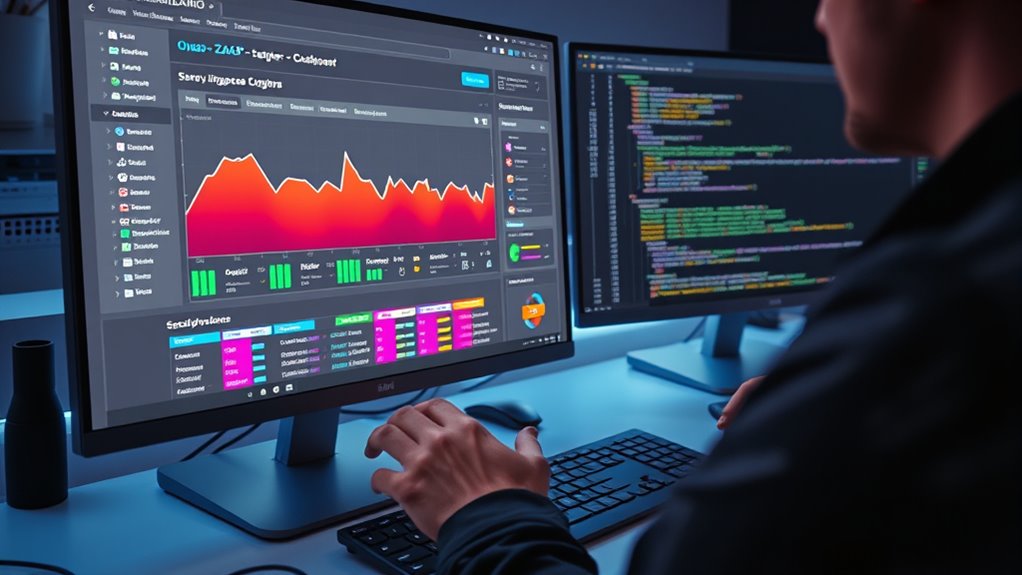To enable security scanning in your CI pipeline with OWASP ZAP automation, you can integrate ZAP’s API to run scans automatically whenever code changes occur. This allows you to detect vulnerabilities early, generate detailed reports, and receive alerts for high-severity issues. By customizing scans for your application architecture and scheduling them during deployment, you guarantee continuous security checks. Keep exploring how to streamline your security process with OWASP ZAP in your development cycle.
Key Takeaways
- Integrate ZAP API with CI tools to automate vulnerability scans during development and deployment cycles.
- Schedule and trigger scans automatically to identify security issues early in the CI pipeline.
- Configure ZAP to generate detailed vulnerability reports with severity levels for prioritized fixing.
- Set up alerts and notifications for high-severity vulnerabilities to enable rapid response and remediation.
- Use automation to maintain continuous security monitoring and ensure compliance throughout development.

Integrating security scanning into your continuous integration (CI) pipeline is essential for catching vulnerabilities early and maintaining a secure application. When you automate security testing with OWASP ZAP, you streamline the process of identifying weaknesses before they reach production. One of the key aspects of this integration is API integration, which allows ZAP to communicate seamlessly with your CI tools and other systems. By connecting ZAP through APIs, you enable automated scans to run automatically whenever code changes are pushed, ensuring continuous security checks without manual intervention. This setup not only saves time but also guarantees that security testing keeps pace with your development cycle.
Automate security scans in your CI pipeline through API integration for continuous, efficient vulnerability detection.
As you incorporate ZAP into your CI pipeline, vulnerability reporting becomes a crucial component. ZAP generates detailed reports highlighting security issues, which you can review to prioritize fixes. These reports include information on the type of vulnerability, affected endpoints, and severity level, providing you with actionable insights. When integrated properly, vulnerability reporting is automated and consolidated, giving your team a complete view of your application’s security posture at any given time. This immediate feedback loop helps you address issues swiftly, reducing the risk of deploying vulnerable code. Furthermore, by automating report generation, you make sure that security findings are consistently documented, making compliance and audit processes smoother.
You can customize how ZAP performs scans within your CI pipeline to suit your application’s specific architecture and threat landscape. For example, you can set up scheduled scans targeting new features or critical endpoints, ensuring that vulnerabilities are caught before they become a problem. By leveraging API integration, you can also trigger scans as part of your deployment process, making security an integral part of your release cycle. This proactive approach helps you catch vulnerabilities early and reduces the likelihood of security issues slipping through later stages.
Additionally, integrating ZAP with your CI system means you can set up alerts and notifications based on scan results. When a scan detects a high-severity vulnerability, your team gets notified immediately, enabling rapid response. You can automate actions such as blocking a deployment until issues are resolved or marking certain vulnerabilities for urgent fixes. This level of automation enhances your security posture by making vulnerability management efficient and responsive. Incorporating project-specific security considerations ensures that your scans remain relevant and effective against tailored threats. Overall, combining API integration with vulnerability reporting in your CI pipeline empowers you to maintain a strong security stance, ensuring your application remains resilient against emerging threats.
Frequently Asked Questions
How Do I Handle False Positives in Automated Scans?
When handling false positives, you should first review scan results carefully to identify potential inaccuracies. Use scan validation techniques, like manual verification or automated filters, to confirm true vulnerabilities. Regularly tune your security scan settings to reduce false positives, and document recurring issues for future reference. This proactive approach helps you focus on real threats, saving time and improving your overall security posture.
What Are the Best Practices for Integrating ZAP Into CI Pipelines?
Your CI pipeline can be a fortress with the right security automation, making it nearly impenetrable. To integrate ZAP effectively, you should automate scans within your workflows, ensuring consistent testing without manual intervention. Use CI tools like Jenkins, GitLab CI, or Travis CI, and run ZAP as part of your build process. Always analyze results, handle false positives, and refine configurations for seamless, reliable security automation that keeps your app safe.
Can ZAP Be Used for Testing APIS and Microservices?
Yes, you can use ZAP for API testing and microservice security. It effectively scans APIs for vulnerabilities and helps guarantee your microservices are secure. You’ll want to configure ZAP to target your API endpoints, automate scans in your CI pipeline, and analyze the results. This way, you catch security issues early and maintain a robust security posture for your microservices architecture.
How Do I Manage ZAP Scan Reports Securely?
Oh, the irony of securing scan reports—like locking away treasure you wish everyone could see! You should store ZAP reports in a secure location, using encrypted storage or protected servers. Implement strict access control so only authorized team members can view them. Regularly review permissions and avoid sharing reports via insecure channels. This way, your sensitive security data stays safe, even amidst the chaos of continuous integration.
What Are the Limitations of OWASP ZAP in CI Environments?
You should be aware that OWASP ZAP has limitations in CI environments, especially regarding scanning accuracy and resource consumption. Its scanning accuracy might be affected by dynamic web app changes or complex interactions, leading to false positives or missed issues. Additionally, it can consume significant resources, slowing down your CI pipeline. To mitigate these, optimize scan configurations, run targeted scans, and monitor resource usage carefully to maintain efficiency and reliability.
Conclusion
By automating security scans with OWASP ZAP in your CI pipeline, you considerably reduce vulnerabilities and guarantee consistent testing. Many believe that manual testing alone suffices, but automation reveals hidden issues faster and more reliably. Incorporating OWASP ZAP proves that proactive security measures not only catch flaws early but also build a resilient development process. Ultimately, integrating automated scans isn’t just best practice—it’s essential for maintaining robust, secure applications in today’s fast-paced development landscape.









